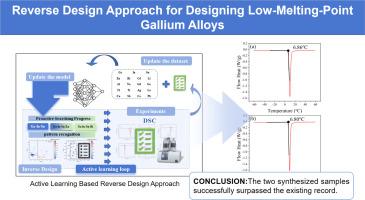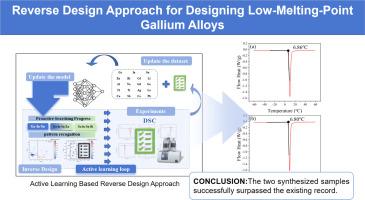Creating Gallium-based alloys with the lowest melting point via reverse design approach
IF 9.3
1区 材料科学
Q1 MATERIALS SCIENCE, MULTIDISCIPLINARY
引用次数: 0
Abstract
Gallium-based low-melting-point alloys, also known as gallium-based liquid metals, are widely used across various fields due to their excellent convective properties. However, their phase transition and volume expansion during freezing may present safety risks, which highlights the need for alloys with even lower melting points for enhanced adaptability in low-temperature environments. In this study, we introduce an active learning-based reverse design framework to accurately identify gallium-based alloys with reduced melting points. Through two rounds of iteration, we successfully designed and synthesized Ga60.40In22.49Sn15.60Zn1.51 and Ga59.33In24.74Sn14.51Zn1.42, with melting points of 6.80 °C and 6.85 °C, which surpassed the lowest record of 8 °C reported. These findings demonstrate that this active learning-based reverse design method can significantly accelerate the development of low-melting-point alloys and offer valuable insights for the reverse design of other materials.


通过逆向设计方法制造熔点最低的镓基合金
镓基低熔点合金,又称镓基液态金属,因其优异的对流性能而广泛应用于各个领域。然而,它们在冻结过程中的相变和体积膨胀可能会带来安全风险,这凸显了对熔点更低的合金的需求,以增强在低温环境中的适应性。在本研究中,我们引入了一种基于主动学习的反向设计框架,以准确识别熔点降低的镓基合金。经过两轮迭代,我们成功设计合成了Ga60.40In22.49Sn15.60Zn1.51和Ga59.33In24.74Sn14.51Zn1.42,熔点分别为6.80°C和6.85°C,突破了8°C的最低记录。这些发现表明,这种基于主动学习的反设计方法可以显著加速低熔点合金的发展,并为其他材料的反设计提供有价值的见解。
本文章由计算机程序翻译,如有差异,请以英文原文为准。
求助全文
约1分钟内获得全文
求助全文
来源期刊

Acta Materialia
工程技术-材料科学:综合
CiteScore
16.10
自引率
8.50%
发文量
801
审稿时长
53 days
期刊介绍:
Acta Materialia serves as a platform for publishing full-length, original papers and commissioned overviews that contribute to a profound understanding of the correlation between the processing, structure, and properties of inorganic materials. The journal seeks papers with high impact potential or those that significantly propel the field forward. The scope includes the atomic and molecular arrangements, chemical and electronic structures, and microstructure of materials, focusing on their mechanical or functional behavior across all length scales, including nanostructures.
 求助内容:
求助内容: 应助结果提醒方式:
应助结果提醒方式:


